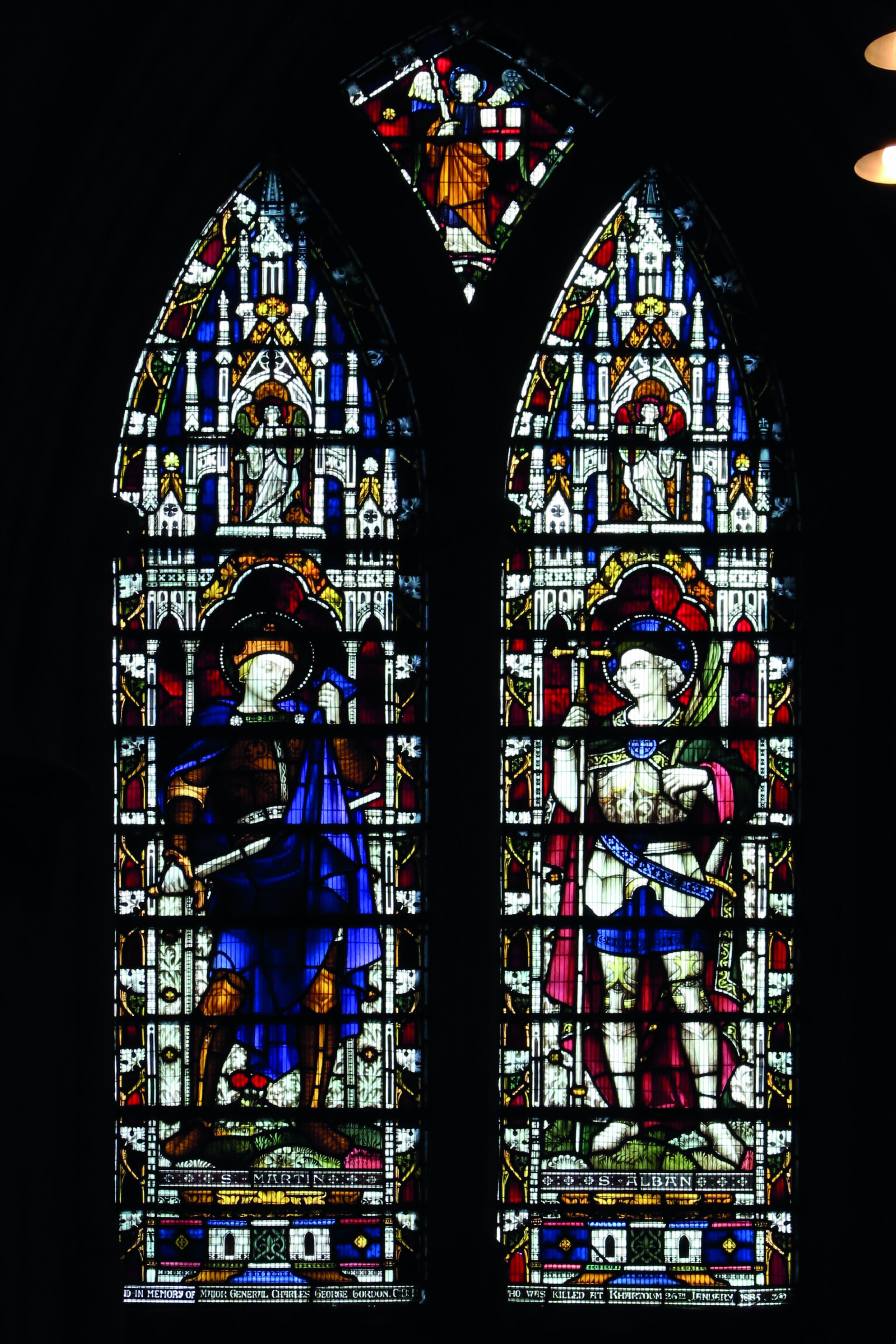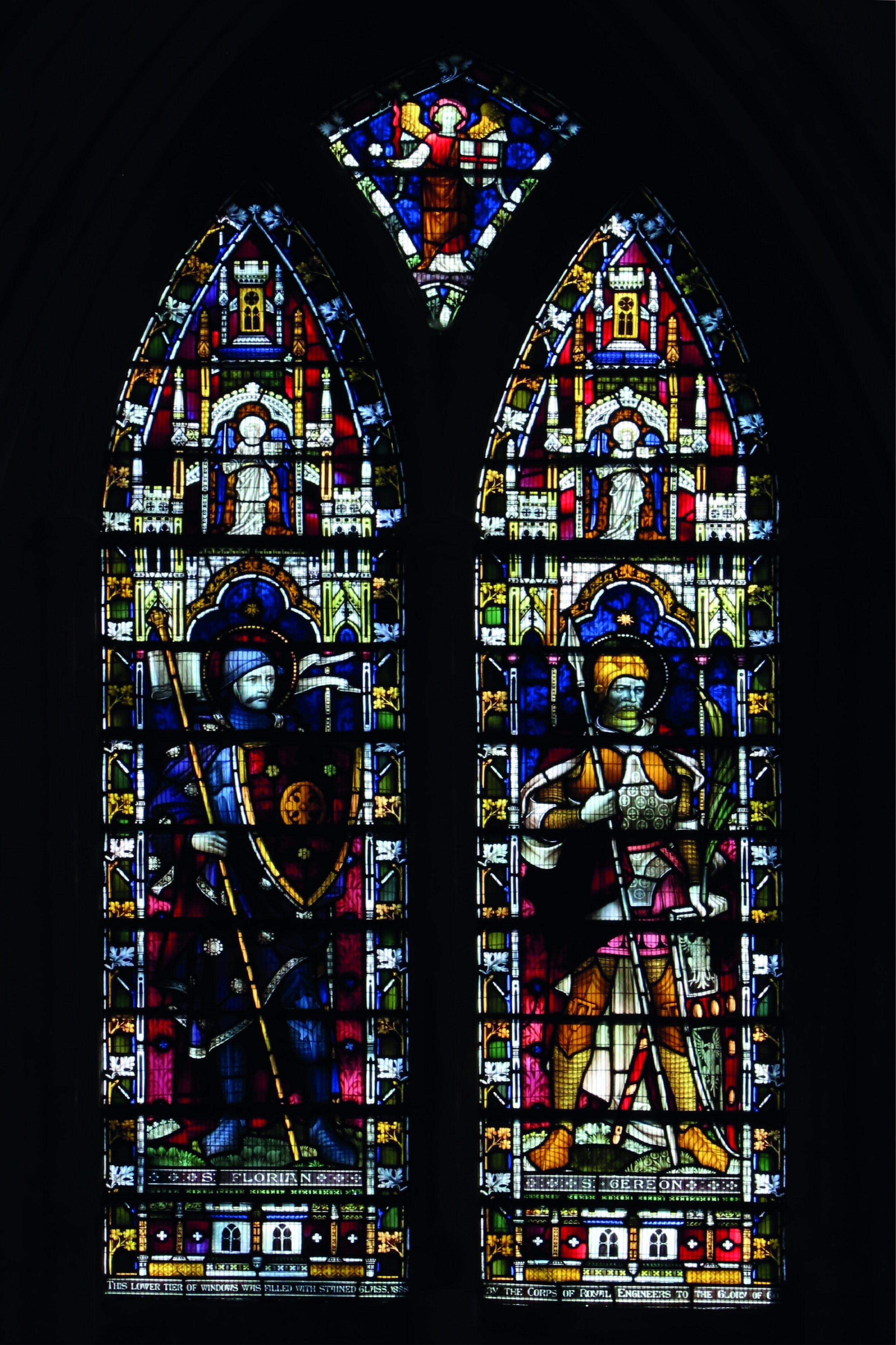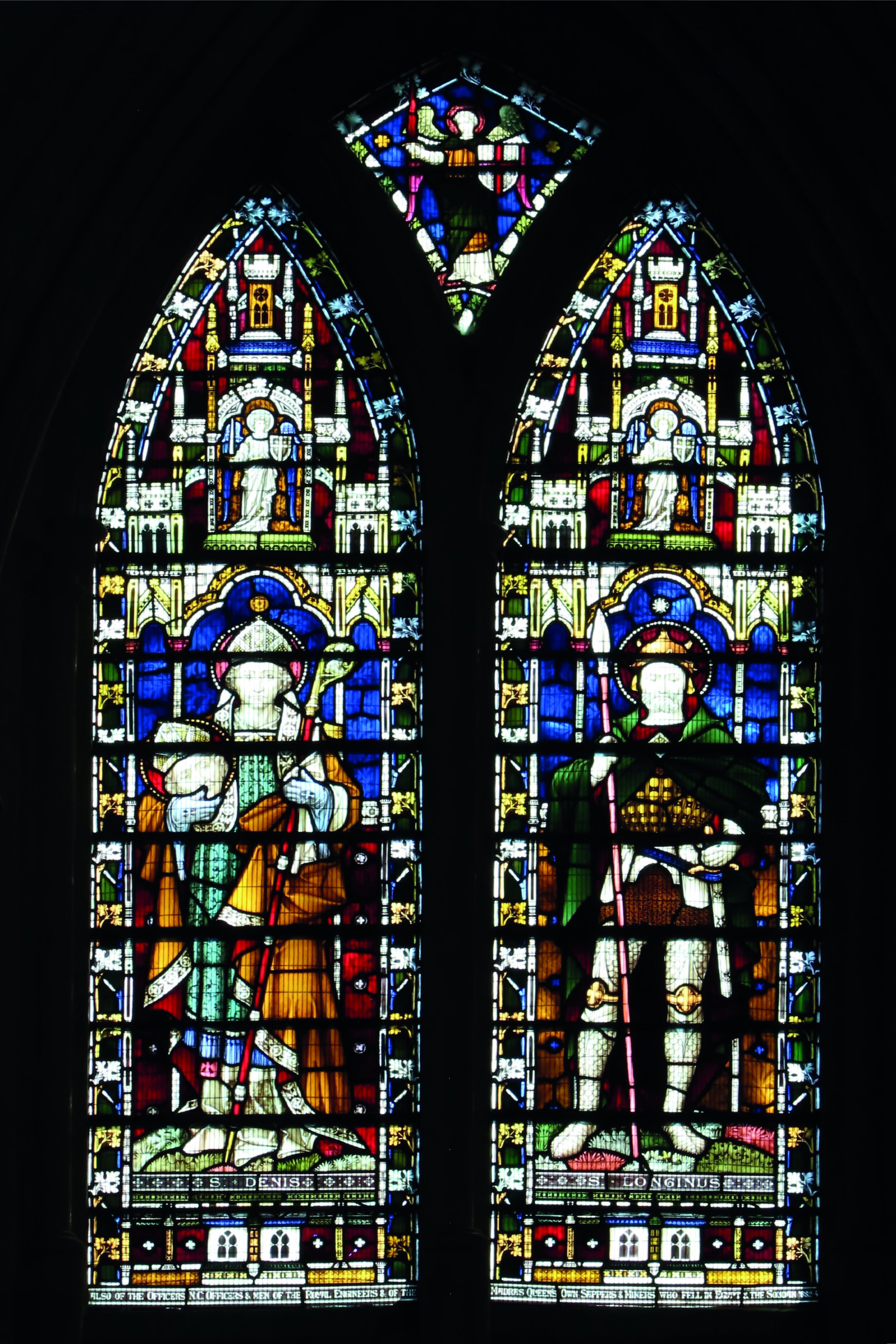Major General Charles Gordon and casualties of the Egypt and Sudan Campaigns (1882-1885)
/Major General Charles George Gordon C.B…. Captain F. J. Romilly and Lieutenant E. M. B. Newman killed at Tofrek. Lieutenant W. B. Askwith killed at Suakin and 31 noncommissioned and 74 men of the Royal Engineers and of the Queens own Madras Sappers and Miners who fell in the Egyptian and Soudan Campaigns 1882 To 1885’.



Two lights. East - inscription 'S. Florian' below a figure of the saint in armour with a shield and banner. West - inscription 'S Gereon' below a figure of the saint in medieval armour carrying a lance, shield and palm. Each figure beneath an architectural canopy in the centre of which stands an angel with a shield and drawn sword. Headlight - an angel with a shield and drawn sword. Headlight - an angel with shield and drawn sword.
Captain F. J. Romilly and Lieutenant E. M. B. Newman
Captain Francis Romilly was born on March 10th 1849, the eldest son of Mr. George Romilly and grandson of Lt. Col. Romilly, RE who constucted the "shaft" at Dover by which troops could gain access to the the heights. He was commissioned from the R.M.A. in July 1870 and went to India in 1873 to join the Madras Public Works Department. In 1882 he volunteered for service with the Egyptian Campaign, but was not required.
In February 1885 he was sent with the Madras Sappers and Miners to the Sudan, leaving Bangalore on 24th February and arriving at Suakim on 13th March. Nine days later he was dead, speared to death while superintending the construction of General Sir John McNeill's zareba on 22nd March. He had married the daughter of Mr. Dennis de Bordt Hovell of Boreham Holt, Elstree. He left a widow and three young children.
From the RE Journal 1885
The Attack on General McNeill's Zariba near Suakim
On 22nd March 1885, Major-General Sir John McNeill V.C., C.M.G. started from Suakim at seven in the morning with the Berkshire Regiment and other units, including a detachment of Royal Engineers, in the direction of Tamaai, in order to construct zaribas (strong points made of thorn bushes). These were to be garrisoned by the Berkshires while the other units returned to camp.
After McNeill's column in two square had disappeared into the desert, a strong body of the enemy came surging up to Suakim in the belief that the town had been left unguarded. On discovering their mistake, they swung round and followed up McNeill's expedition, which by this time had constructed one zariba and had commenced another.
McNeill had neglected to take the necessary precautions against a surprise attack. Firstly, he had constructed his zaribas in dense scrub instead of in the open, thus affording cover for an approaching enemy, secondly, he had posted his vedettes (mounted sentries) too close to the working parties and in insufficient numbers. The enemy's attack took the force completely unawares, and near-disaster followed. The soldiers were scattered and had to run for their piled arms. The transport animals stampeded and drove the camp followers headlong into the troops. Many native followers were killed and large numbers of the animals were ham-strung. The troops eventually formed squares, but the enemy broke into these and had to be driven out at the point of the bayonet.
After half-an-hour's fierce fighting the firm stand made by the troops caused the enemy to withdraw; it had been a very close thing. In this engagement both Captain Romilly and Lieutenant Newman lost their lives. Captain Romilly was killed while charging to save Lieutenant Drury of the Bengal Army. He was speared in the back. Lieutenant Newman was badly cut up, his left arm being hacked off at the elbow and the top of his skull clean sliced off.
From the R.E.Journal 1885 and "Recent British Battles" published by Cassells and Co.
The bulk of the Mahdi's forces around Suakim were the Hadendowa - the 'Fuzzy-Wuzzies' as they came to be called by the British soldier, because their hair frizzed out in all directions from their head. They are renowned for having broken a British square and are remembered by Kipling in his poem "Fuzzy-Wuzzy"
This action was known as the battle of Tofrek, and a clasp Tofrek was awarded to men who were engaged to be worn on the Egypt medal. The Berkshire was granted the title of Royal by Queen Victoria for Its gallant behaviour during this battle.
Letter from Lieutenant E.M.B.Newman to his father
In a letter to his father written only a few weeks before his death, he tells of the movement of the Madras Sappers and Miners from Bangalore en route to Suakin. He wrote how the families of the native soldiers flocked around the departing men, and how one of then gave his daughter & rupee to stop her crying - "I didn't think the natives had so much feeling."
The muleteers were "bobbery", but were promised 25 lashes of the cat if they did not behave. On the way they were presented with a case of champagne, but being a teetotaller he gave it to captain Romilly.* He hoped to be at Suakim to help turn out Oman Digna, and anticipated being employed on the Berber railway.**
He believed his native sappers would be good men in a fight, and went on to quote examples from previous campaigns. He expected the Sudan to be much hotter than India and that he would need his helmet. He was sorry to leave India, as it was better for a poor officer than England. His father was not to expect news of him for some time. In the event his father did not hear fron him again.
* Capt.Romilly died with him at Tofrek on 22 March.
** The Berber Railway. failed to materialize as the town was captured by the Mahdi's forces.
Lieutenant W. B. Askwith
Lieutenant Askwith was a casualty of the campaign against the Mahdi in the Sudan, Suakim, on the Red Sea. During the campaign Suakim was held by British forces. It was constantly harassed and besieged by Osman Digna, one of the Mahdi's most competent lieutenants.
While Suakim was under siege mines were laid in the outer redoubts to prevent the enemy occupying them at night, destroying them and carrying off the sandbags. These mines could be detonated electrically from the gunboats lying off shore. The enemy, however, were canny enough to cut the wires and render the mines harmless.
Lieutenant Askwith an expert in land mines was sent to Suakim to lay tread-mines, i.e. mines which would be buried in the sand and explode when trodden on. He would ride out at sunset and place mines in the redoubts to discourage the enemy from occup-ving them and breaking down the parapets. One morning it was found that one of the largest works had been entered and the sandbags carried off. Askwith was told to visit the redoubt to see if the mine had been taken away by the Mahdi's men. A short time later an explosion was heard and when troops were sent out to investigate it was found that Lieut. Askwith had been blown to pieces. Obviously he had been kneeling to examine the mine when it went off, for all that was found of his body were his legs. His notebook containing details of the positions of the other mines was destroyed with him, and this made the subsequent lifting of them a dangerous business.
*Vide" life and Adventure in Peace and Way" by Major-Coneral Or Blliott Wood K.C.B.,D.I., J.P. pub. Arnold & Co. 1924.
From the notebooks ‘The Naval and Military Memorials of Rochester Cathedral’ (1979)
by Roy Trett, OBE, TD,
Rochester Cathedral Chapter Library
The medieval tombs of the Presbytery and Quire Transept have had a tortured history which many effigies apparently moved and several defaced along with the medieval memorials and brasses over the Early Modern period.
Rochester Cathedral features an exceptionally large collection of Colonial-era military memorials and artefacts. This series has begun to highlight the stories behind these collections and their place in our global heritage.





